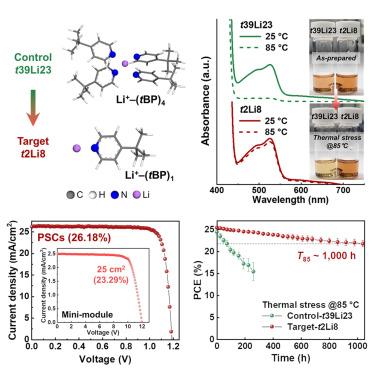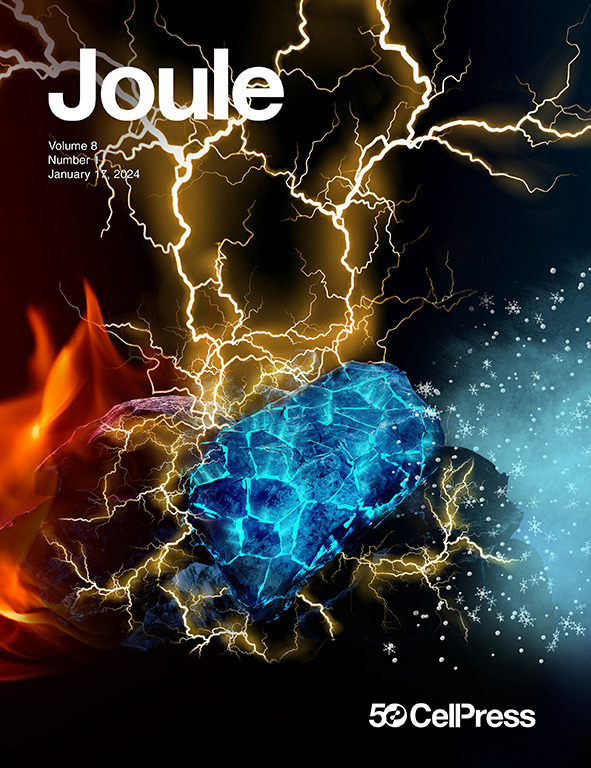De-doping engineering for efficient and heat-stable perovskite solar cells
IF 38.6
1区 材料科学
Q1 CHEMISTRY, PHYSICAL
引用次数: 0
Abstract
In conventional n-i-p perovskite solar cells, unsolved issues persist, particularly concerning notorious performance degradation under prolonged heat exposure at 85°C. By reducing the concentration of 4-tert-butylpyridine (tBP) and lithium bis(trifluoromethanesulfonyl)imide and adjusting their molar ratio to one, we achieved a dramatic increase in the heat stability of the PSC while boosting its power conversion efficiency (PCE). The formation of a 1:1 Li+-tBP complex was crucial for preventing free tBP molecules in the hole-transporting layer (HTL), suppressing the de-doping of the p-type HTL by tBP and the release of tBP vapor under heat stress. Consequently, the PSCs accomplished a PCE of 26.18% (certified 26.00%) while demonstrating remarkable resilience to heat exposure at 85°C due to the raised glass transition temperature of the HTL. Furthermore, a perovskite solar mini-module with an aperture area of 25 cm2 achieved a PCE of 23.29%, highlighting their potential for commercial PSC deployment.


去掺杂工程实现高效、热稳定的过氧化物太阳能电池
在传统的n-i-p包晶太阳能电池中,仍存在一些尚未解决的问题,尤其是在85°C高温下长时间暴露时性能下降的问题。通过降低 4-叔丁基吡啶(tBP)和双(三氟甲磺酰基)亚胺锂的浓度并将它们的摩尔比调整为 1,我们显著提高了 PSC 的热稳定性,同时提高了其功率转换效率(PCE)。1:1 Li+-tBP 复合物的形成对于防止空穴传输层(HTL)中出现游离的 tBP 分子、抑制 tBP 对 p 型 HTL 的去掺杂以及热应力下 tBP 蒸汽的释放至关重要。因此,PSCs 的 PCE 达到了 26.18%(认证值为 26.00%),同时由于 HTL 玻璃化转变温度的提高,在 85°C 的高温下表现出了卓越的耐热性。此外,孔径面积为 25 平方厘米的过氧化物太阳能微型模块的 PCE 达到了 23.29%,这突出表明了它们在商用 PCSC 部署方面的潜力。
本文章由计算机程序翻译,如有差异,请以英文原文为准。
求助全文
约1分钟内获得全文
求助全文
来源期刊

Joule
Energy-General Energy
CiteScore
53.10
自引率
2.00%
发文量
198
期刊介绍:
Joule is a sister journal to Cell that focuses on research, analysis, and ideas related to sustainable energy. It aims to address the global challenge of the need for more sustainable energy solutions. Joule is a forward-looking journal that bridges disciplines and scales of energy research. It connects researchers and analysts working on scientific, technical, economic, policy, and social challenges related to sustainable energy. The journal covers a wide range of energy research, from fundamental laboratory studies on energy conversion and storage to global-level analysis. Joule aims to highlight and amplify the implications, challenges, and opportunities of novel energy research for different groups in the field.
 求助内容:
求助内容: 应助结果提醒方式:
应助结果提醒方式:


